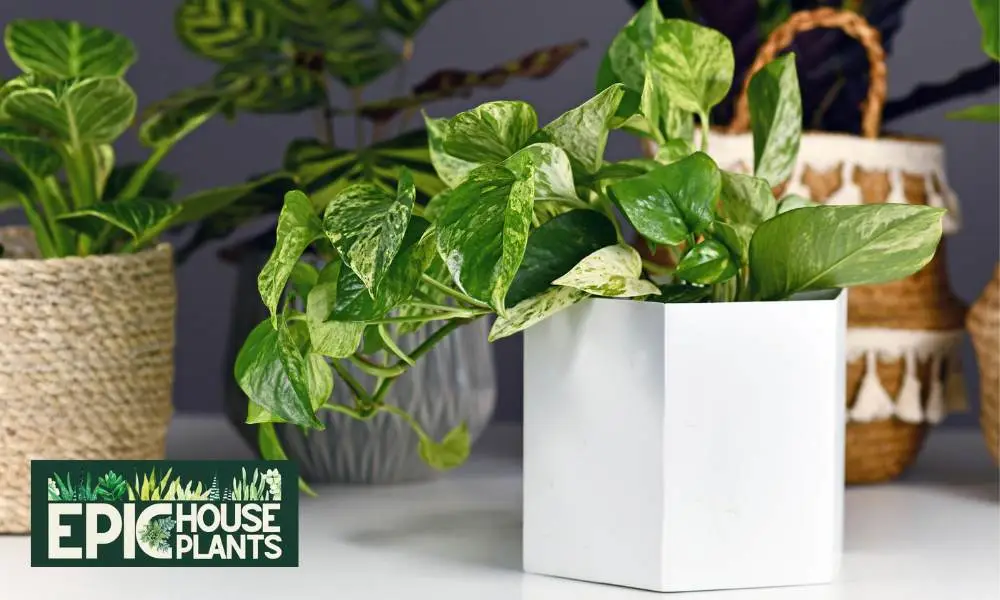Looking to bring nature indoors and elevate your home decor? Training your Pothos plant to climb can be a rewarding endeavor.
The Pothos, also known as Devil’s Ivy, is a popular houseplant with vibrant green leaves that thrives in various indoor conditions. Climbing Pothos adds a captivating vertical dimension to your living space, transforming it into a lush, green oasis. It’s perfect for small apartments or homes with limited floor space.
Let’s explore the secrets to nurturing a climbing Pothos that will flourish in your living space.
Pothos Preferences: Climbing Versus Hanging
Let’s talk about our leafy friends, Pothos plants, and their preferences when it comes to climbing versus hanging. These versatile beauties are known for their easy care and adaptability, making them a popular choice for indoor greenery.
When it comes to Pothos plants, they have a natural instinct to climb. It’s in their DNA! So, if you want to bring out their true potential, you can train them to climb up supports like trellises or moss poles.
Author Note:
Did you know that Pothos, also known as Devil’s Ivy, is a tropical climbing vine that originates from the stunning Solomon Islands?
Not only does this align with their natural growth habit, but it also creates a visually stunning vertical element in your indoor spaces. Imagine a lush green wall of Pothos vines, adding a touch of nature’s beauty to your home.
But hey, we understand that not everyone has the space or desire for climbing plants. That’s where the adaptability of Pothos comes into play. These amazing plants can also be grown as hanging or trailing plants.
Simply place them in a hanging basket or on a shelf, and watch as their vines gracefully cascade downwards, creating a beautiful, cascading effect. It’s like having a living waterfall of greenery in your home!
Whether you choose to let your Pothos climb or hang, one thing is for sure – they will bring life and vibrancy to any space. The choice is yours, and the beauty is guaranteed.
Now, let’s weigh the pros and cons of each growing method:
Climbing Pothos Pros & Cons

Climbing Pothos Pros
- By providing a structure for climbing, you allow them to grow in a way that feels instinctive and natural.
- Climbing Pothos can add a touch of greenery to your space, making a dramatic visual statement.
- This method can encourage larger leaf growth, mimicking the plant’s natural conditions.
- Perfect for small spaces, climbing Pothos utilize walls or trellises, taking up less floor space.
- Like many indoor plants, Pothos can improve air quality, and a larger climbing Pothos may have an even more significant effect due to its size and leaf surface area.
Climbing Pothos Cons
- You’ll need to provide a moss pole, trellis, or other support structures, which can be an additional cost and effort.
- Climbing Pothos may require more regular maintenance, such as tying new growth to supports and adjusting the direction of growth.
- You’ll need a suitable location where the plant can climb undisturbed, which might limit your placement options.
Hanging Pothos Pros & Cons

Hanging Pothos Pros:
- No need for support structures, making them less demanding in terms of training and maintenance.
- Hang them in various locations, from ceilings to shelves, offering more versatility in your decor.
- The trailing vines of a hanging Pothos create a stunning cascading effect, adding to the aesthetic of any room.
- Great for saving space, especially in small apartments or areas with limited floor space.
Hanging Pothos Cons:
- Without support to climb, the leaves may remain smaller compared to climbing Pothos.
- The vines can become long and leggy if not pruned regularly.
- Be cautious of water dripping from hanging baskets during watering, as it could potentially damage floors or furniture.
- You’ll need to find secure places to hang the plant, which might not always align with the best lighting conditions.
Ultimately, whether you choose to encourage your Pothos to climb or let it hang depends on your personal preference and the aesthetic you wish to achieve. Both growing styles are suitable for Pothos and can lead to healthy, thriving plants.
So, go ahead and let your Pothos reach for the stars or gracefully cascade down. Whichever way you choose, these versatile plants will bring life and beauty to your indoor spaces. Happy growing, plant enthusiasts!
Types of Supports That Can Help to Train Pothos Plants to Climb
| Types of Supports | Description |
|---|---|
| Moss Poles | Natural and moisture-retentive surface that encourages the growth of aerial roots. Popular choice for Pothos climbers. |
| Trellises | Sturdy wooden or metal frameworks offering support. Can be placed in the pot or installed against a wall. |
| Lattice Panels | Grid-like structures similar to trellises, providing a framework for Pothos vines to weave through and climb. |
| Coir Poles | Textured poles made from coconut fiber, offering a surface for easy gripping by Pothos aerial roots. |
| Walls and Shelves | Utilize small hooks or adhesive supports to train Pothos vines to climb walls or wrap around shelves. |
| Ropes and Strings | Guide the direction of growth by allowing Pothos to climb along the length of ropes or strings. |
| Wire or Plastic Mesh | DIY climbing structures created using mesh, offering numerous points for Pothos vines to latch onto. |
| Decorative Frames | Hoops or shaped wire forms that Pothos can climb around, creating artistic plant displays. |
Now, here’s the scoop on Pothos plants – while they are primarily grown indoors, they can also thrive outside in certain conditions. So, if you’re looking to add a touch of green to your outdoor space, Pothos might just be the perfect choice.
Step by Step to Train Pothos to Climb a Wall

Are you ready to transform your wall into a lush green tapestry? Training a Pothos plant to climb a wall is easier than you think, and I’m here to guide you through each step with a friendly tone. Let’s get started!
Step 1: Choose the Perfect Wall Location
Find a spot on your wall that gets bright, indirect light. Remember, too much direct sunlight can harm the leaves, while too little light may stunt growth. Also, make sure the location is away from drafts or heat sources to keep your Pothos happy.
Step 2: Prepare Your Pothos for Training
Before you begin, make sure your Pothos is healthy and showing signs of new growth. Give it a good watering the day before you start training. This will make the plant more flexible and less likely to break during the process.
Step 3: Set Up a Support System
Now it’s time to install some clear adhesive hooks or small nails on the wall where you want your Pothos to climb. Space them out in a pattern that allows the plant to naturally follow. Use soft plant ties or twist ties to gently attach the vines to the hooks or nails for initial support. Be careful not to constrict the vines.
Step 4: Train the Vines
Guide the longest vines towards the hooks, gently wrapping or tying them as needed. Let the shorter vines continue to grow until they can reach the support. As your Pothos grows, remember to regularly adjust the ties and guide new growth along the wall. You might even need to add more hooks along the way.
Step 5: Pruning for Fuller Growth
To encourage fuller growth, it’s important to prune your Pothos. Simply cut just above a leaf node, where new leaves emerge. If you want, you can even use the pruned sections for propagation and grow more Pothos plants!
Step 6: Ongoing Care and Maintenance
Keep your Pothos happy by watering it when the top inch of soil feels dry. Remember, over-watering can do more harm than good. Feed your Pothos with a balanced, water-soluble fertilizer every 4-6 weeks during the growing season. And don’t forget to give those leaves a little dusting to keep them healthy and ensure efficient photosynthesis.
Step 7: Monitoring and Adjusting
Regularly check on your Pothos and adjust the ties and hooks as needed. Make sure they’re not too tight and are supporting new growth properly. Keep an eye out for any signs of stress, like yellowing leaves or stunted growth, and adjust your care accordingly.
Author Note:
Training your Pothos to climb a wall is a fun and rewarding process that will bring life and beauty to your indoor space. With a little patience and attention, you’ll soon have a stunning green tapestry adorning your wall. So, let’s get started and create a botanical masterpiece together!
How to Train Your Pothos to Climb a Moss Pole

If you’re looking to support your Pothos’ natural climbing habit and promote its healthy growth, training it to climb a moss pole is the way to go.
Don’t worry, it’s easier than it sounds! Let’s dive into this friendly step-by-step guide on how to train your Pothos to climb a moss pole:
Step 1: Choosing the Perfect Moss Pole
First things first, find a moss pole that suits your Pothos’ needs. Make sure it’s tall enough to accommodate its potential growth. Remember, Pothos can get pretty long! Look for a sturdy moss pole with securely attached moss.
Step 2: Preparing Your Pothos
Before you begin, ensure your Pothos is in good health. Check for plenty of foliage and new growth, indicating it’s ready to climb. Give it a good watering a day before attaching it to the moss pole. This will help ease any transplant stress.
Step 3: Inserting the Moss Pole
Gently insert the moss pole into the pot, near the base of your Pothos. Be careful not to damage the roots as you do this. Make sure the pole stands upright and is firmly placed in the soil. If you’re repotting, this is a great time to do it!
Step 4: Attaching the Vines to the Moss Pole
Now comes the fun part! Take those Pothos vines and gently wrap them around the moss pole. Start with the longest vines and work your way down to the shorter ones as they grow. Use soft plant ties, velcro strips, or even old nylon stockings to loosely attach the vines to the moss pole. Remember, don’t tie them too tightly as it can harm the stems.
Step 5: Encouraging Aerial Roots to Attach
To help your Pothos thrive, mist the moss pole and aerial roots regularly. The moisture will encourage the roots to cling to the moss. Creating a humid environment around your Pothos will also promote the adherence of aerial roots to the moss pole.
Step 6: Ongoing Care and Maintenance
Keep your Pothos happy by watering it when the top inch of soil feels dry. Don’t forget to keep the moss pole moist too! Feed your Pothos with a balanced, water-soluble fertilizer every 4-6 weeks during the growing season. And if you spot any leggy or dead stems, prune them to encourage fuller growth.
Step 7: Regular Adjustments
As your Pothos grows, continue to gently guide and tie new growth to the moss pole. To ensure even growth on all sides, give the pot a little rotation every now and then.
Step 8: Monitoring Plant Health
Keep a close eye on your Pothos for any signs of pests and treat them promptly. Also, watch out for any leaf discoloration or drooping, as it could indicate watering or light issues.
Friendly Tips:
- Patience is Key: Training your Pothos to climb takes time, so be patient and let the plant grow at its own pace.
- Avoid Overhandling: Remember, too much adjusting or moving can stress your plant out. Make changes gently and only when necessary.
By following these friendly steps, you’ll be well on your way to training your Pothos to climb a moss pole like a pro. And remember, to keep your Pothos happy and healthy, make sure to repot them when they become rootbound. Happy gardening!
FAQs
What should I do if the aerial roots of my Pothos are not clinging to the support?
If the aerial roots are not clinging, you can increase humidity around the plant, as moisture encourages root attachment. You may also need to manually tie the vines to the support until the roots take hold.
Can I convert my hanging Pothos into a climbing one?
Yes, you can train a hanging Pothos to become a climbing one. Introduce a support structure and gently start guiding and tying the vines to it.
Conclusion
Congratulations on taking the first step towards creating a stunning indoor oasis! With the right support, care, and a touch of artistic flair, your climbing Pothos will not only purify your air but also bring joy and tranquility to your daily life.
So why wait? Use the knowledge you’ve gained from this guide and embark on your journey to train your Pothos to climb. Whether you choose trellises, poles, or other creative solutions, your green thumb will shine through, creating a harmonious and inviting living environment. Enjoy the adventure and the beauty that awaits you as your Pothos reaches new heights!
Author

Pudji Haryanto
Pudji Haryanto is a writer and urban farmer with a passion for cultivating plants. He has over 15 years of experience in agriculture and currently manages a 65,000 square foot rice-field and yard filled with various plants, including vegetables, spices, flowers, and garden plants.

